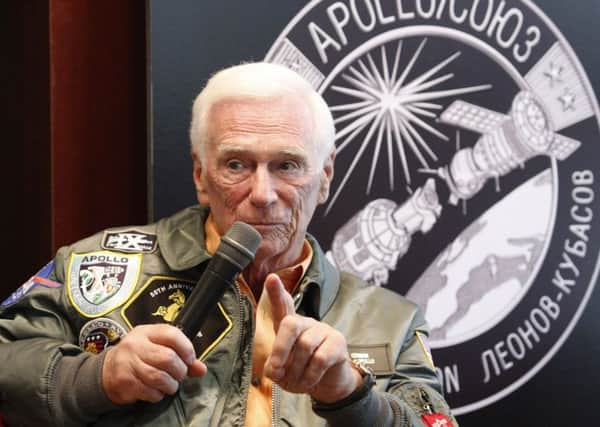Obituary: Gene Cernan, astronaut


Astronaut Gene Cernan traced his only child’s initials in the dust of the lunar surface. Then he climbed into the lunar module for the ride home, becoming the last person to walk on the moon. It was a moment that defined the Apollo 17 commander in both the public eye and his own. “Those steps up that ladder, they were tough to make,” he said in 2007. “I didn’t want to go up. I wanted to stay a while.”
Cernan died on Monday at a Houston hospital after ongoing heath issues. “Even at the age of 82, Gene was passionate about sharing his desire to see the continued human exploration of space and encouraged our nation’s leaders and young people to not let him remain the last man to walk on the Moon,” his family said.
Advertisement
Hide AdAdvertisement
Hide AdOn 14 December 1972, Cernan became the last of only a dozen men to walk on the moon. Cernan called it “perhaps the brightest moment of my life”. He guided the lander, Challenger, into a lunar valley called Taurus-Littrow, with Harrison “Jack” Schmitt at his side on 11 December 1972. He recalled the silence after the lunar lander’s engine shut down. “That’s where you experience the most quiet moment a human being can experience in his lifetime,” Cernan said in 2007. “There’s no vibration. There’s no noise. The ground quit talking. Your partner is mesmerised. He can’t say anything. The dust is gone. It’s a realisation, a reality, all of a sudden you have just landed in another world on another body out there [somewhere in the] universe, and what you are seeing is being seen by human beings – human eyes – for the first time.”
Three days earlier, Cernan, Schmitt and Ronald Evans had blasted off atop a Saturn rocket in the first manned nighttime launch from Kennedy Space Centre. Evans remained behind as pilot of the command module that orbited the moon while the other two landed on the moon’s surface. Cernan and Schmitt, a geologist, spent more than three days on the moon, including more than 22 hours outside the lander, and collected 249 pounds of lunar samples.
“In that whole three days, I don’t think there’s anything that became routine,” Cernan recalled. “But if I had to focus on one thing ... it was just to look back at the overwhelming and overpowering beauty of this Earth. To go a quarter of a million miles away into space and have to take time out to sleep and rest ... I wished I could have stayed awake for 75 hours straight. I knew when I left I’d never have a chance to come back.”
Completing their third moon walk on 14 December, Schmitt returned to the lunar module and was followed by Cernan.
“We leave as we came and, God willing, as we shall return, with peace and hope for all mankind,” Cernan said.
He later acknowledged that he had grasped for words to leave behind, knowing how the world remembered Neil Armstrong’s “giant leap for mankind” on stepping on the moon in 1969.
Before heading home, Cernan said he drew the letters “TDC” – the initials of his then nine-year-old daughter, Teresa Dawn – with his finger on the dusty grey lunar surface. He said he imagined someone in the distant future would find “our lunar rover and our footprints and those initials and say, ‘I wonder who was here? Some ancient civilisation was here back in the 20th century, and look at the funny marks they made’.”
Eugene Cernan was born in 1934 in Chicago and graduated from Indiana’s Purdue University in 1956 with a degree in electrical engineering. He had been a Navy pilot and earned a master’s degree in aeronautical engineering when NASA selected him in October 1963 as one of 14 members of its third astronaut class.
Advertisement
Hide AdAdvertisement
Hide AdIn 1966, he was pilot of Gemini 9, a three-day flight with command pilot Tom Stafford and became the second American to walk in space, spending more than two hours outside the Gemini spacecraft.
Cernan would later call the mission, “that spacewalk from hell”. “It was very serious,” said space historian Roger Launius. “He lost all kinds of water, his equipment did not work effectively. He overheated. His visor glossed over with water, he could barely see. He barely got back in the spacecraft.”
Cernan’s sweat so much he lost 13 pounds. The space agency was forced to go back to the drawing board.
With the Apollo programme underway, he flew on Apollo 10 in May 1969. It took Cernan and Stafford, aboard the lunar module Snoopy, to within 9.5 miles of the moon’s surface.
In 1973 Cernan became special assistant to the programme manager of the Apollo programme at Johnson Space Centre in Houston, assisting in planning the US-Soviet Apollo-Soyuz mission.
He retired from NASA three years later. He worked for a Houston energy firm, Coral Petroleum, then in 1981 began his own aerospace consulting company. He eventually became chairman of an engineering firm that worked on NASA projects. He also worked as aTV commentator for shuttle flights in the 1980s.
Teresa was Cernan’s only child with wife Barbara. The couple married in 1961 and divorced 20 years later. In 1987, he married again, to Jan Nanna, and they lived in Houston.
“I can always walk on Main Street again, but I can never return to my Valley of Taurus-Littrow, and that cold fact has left me with a yearning restlessness,” he wrote in his 1999 autobiography.
Advertisement
Hide AdAdvertisement
Hide Ad“It was perhaps the brightest moment of my life, and I can’t go back,” he said. “Enriched by a singular event that is larger than life, I no longer have the luxury of being ordinary.”
ASSOCIATED PRESS